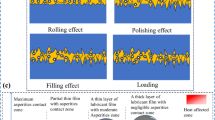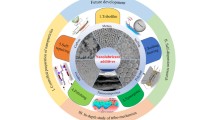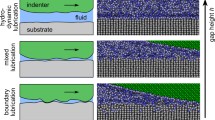Abstract
This study employs molecular dynamics simulation to examine the tribological behavior of nano zinc oxide (nano-ZnO) lubricated with decanol. The changes in electrostatic interaction energy, molecular structure, and chemical reactions during the friction process were analyzed. For ZnO-decanol-ZnO system, the simulation revealed a notable reduction in the coefficient of friction for nano-ZnO, decreasing from 0.49 (at 0.5 GPa and 100 m/s) to 0.18 (at 3 GPa and 20 m/s). This improvement is attributed to the enhanced adsorption ability and temperature stabilization provided by the decanol lubricant. Furthermore, an increase in velocity induces elastoplastic deformation and wear on the sliding surface, leading to a decline in tribological performance.











Similar content being viewed by others
Data Availability
The data that support the findings of this study are available on request.
References
Yang, H., Huang, X., Duan, B., Wu, L., Wang, H., Feng, X., et al.: Dense dislocations induced ductile SnTe thermoelectric semiconductor over a wide range of temperatures. J. Mater. Sci. Technol. 144, 213–218 (2023). https://doi.org/10.1016/j.jmst.2022.11.003
Liu, G., Luan, R., Qi, Y., Gong, L., Cao, J., Wang, Z., et al.: Organic Tribovoltaic nanogenerator with electrically and mechanically tuned flexible semiconductor textile. Nano Energy (2023). https://doi.org/10.1016/j.nanoen.2022.108075
Zhang, Q., Liu, J., Tu, C., Zhai, D., He, M., Lu, J.: High-performance β-Ga2O3 Schottky barrier diodes and metal-semiconductor field-effect transistors on a high doping level epitaxial layer. J. Alloys Compounds. (2023). https://doi.org/10.1016/j.jallcom.2023.168732
Lei, H., Li, J., Kong, X., Wang, L., Peng, X.: Toward surface chemistry of semiconductor nanocrystals at an atomic-molecular level. Acc. Chem. Res. 56, 1966–1977 (2023). https://doi.org/10.1021/acs.accounts.3c00185
Huang, M.H., Mao, S., Feick, H., Yan, H., Wu, Y., Kind, H., et al.: Room-temperature ultraviolet nanowire nanolasers. Science 292, 1897–1899 (2001). https://doi.org/10.1126/science.1060367
Wang, Z.L., Song, J.: Piezoelectric nanogenerators based on zinc oxide nanowire arrays. Science 312, 242–246 (2006). https://doi.org/10.1126/science.1124005
Yan, X., Dong, H., Li, Y., Lin, C., Park, C., He, D., et al.: Phase transition induced strain in ZnO under high pressure. Sci. Rep. 6, 24958 (2016). https://doi.org/10.1038/srep24958
McCook, N.L., Boesl, B., Burris, D.L., Sawyer, W.G.: Epoxy, ZnO, and PTFE nanocomposite: friction and wear optimization. Tribol. Lett. 22, 253–257 (2006). https://doi.org/10.1007/s11249-006-9089-5
Li, D., Wu, C., Ruan, L., Wang, J., Qiu, Z., Wang, K., et al.: Electron-transfer mechanisms for confirmation of contact-electrification in ZnO/polyimide-based triboelectric nanogenerators. Nano Energy (2020). https://doi.org/10.1016/j.nanoen.2020.104818
Pietruszka, R., Witkowski, B.S., Zimowski, S., Stapinski, T., Godlewski, M.: Abrasion resistance of ZnO and ZnO: Al films on glass substrates by atomic layer deposition. Surf. Coat. Technol. 319, 164–169 (2017). https://doi.org/10.1016/j.surfcoat.2017.04.007
Goto, M., Kasahara, A., Konishi, Y., Oishi, T., Tosa, M., Yoshihara, K.: Frictional property of zinc oxide coating films observed by lateral force microscopy. Jpn. J. Appl. Phys. 42, 4834–4836 (2003). https://doi.org/10.1143/jjap.42.4834
Goto, M., Kasahara, A., Tosa, M.: Reduction in frictional force of ZnO coatings in a vacuum. Jpn. J. Appl. Phys. 47, 8914–8916 (2008). https://doi.org/10.1143/jjap.47.8914
Prasad, S.V., Zabinski, J.S.: Tribological behavior of nanocrystalline zinc oxide films. Wear 203, 498–506 (1997). https://doi.org/10.1016/s0043-1648(96)07448-0
Nainaparampil, J.J., Zabinski, J.S., Prasad, S.V.: Nanotribology of single crystal ZnO surfaces: restructuring at high temperature annealing. J. Vac. Sci. Technol., A: Vac., Surf. Films 17, 1787–1792 (1999). https://doi.org/10.1116/1.581891
Prasad, S.V., Walck, S.D., Zabinski, J.S.: Microstructural evolution in lubricious ZnO films grown by pulsed laser deposition. Thin Solid Films 360, 107–117 (2000). https://doi.org/10.1016/s0040-6090(99)00880-9
Chai, Z.M., Lu, X.C., He, D.N.: Atomic layer deposition of zinc oxide films: effects of nanocrystalline characteristics on tribological performance. Surf. Coat. Technol. 207, 361–366 (2012). https://doi.org/10.1016/j.surfcoat.2012.07.021
Chai, Z.M., Liu, Y.H., Lu, X.C., He, D.N.: Reducing friction force of si material by means of atomic layer-deposited ZnO films. Tribol. Lett. 56, 67–75 (2014). https://doi.org/10.1007/s11249-014-0383-3
Zhimin, C., Xinchun, L., He, D.: Friction mechanism of zinc oxide films prepared by atomic layer deposition. RSC Adv. 5, 55411–55418 (2015). https://doi.org/10.1039/C5RA05355B
Chai, Z.M., Liu, Y.H., Lu, X.C., He, D.N.: Influence of crystal structure on friction coefficient of ZnO films prepared by atomic layer deposition. Sci. China Technol. Sci. 59, 506–512 (2016). https://doi.org/10.1007/s11431-015-5979-9
Wang, J.H., Li, X.R., Deng, Y.Y., Chen, S.A., Liang, W.F., Zhang, L.X., et al.: Carbon quantum dots doped with silver as lubricating oil additive for enhancing tribological performance at various temperatures. Appl. Surface Sci. (2022). https://doi.org/10.1016/j.apsusc.2022.154029
Cui, Y., Xue, S., Wang, S., Chen, X., Liu, S., Ye, Q., et al.: Fabrication of carbon dots intercalated MXene hybrids via laser treatment as oil-based additives for synergistic lubrication. Carbon 205, 373–382 (2023). https://doi.org/10.1016/j.carbon.2023.01.053
Yagi, K., Nishida, K., Sugimura, J.: Relationship between the molecular structure of lubricants and appearance of anomalous film shapes in elastohydrodynamic lubrication conditions. Tribol. Int. (2020). https://doi.org/10.1016/j.triboint.2020.106574
Liang, H., Xu, M., Bu, Y., Chen, B., Zhang, Y., Fu, Y., et al.: Confined interlayer water enhances solid lubrication performances of graphene oxide films with optimized oxygen functional groups. Appl. Surf. Sci. 485, 64–69 (2019). https://doi.org/10.1016/j.apsusc.2019.04.190
Berman, D., Erdemir, A., Sumant, A.V.: Graphene: a new emerging lubricant. Mater. Today 17, 31–42 (2014). https://doi.org/10.1016/j.mattod.2013.12.003
Qi, W., Huang, P., Chen, X., Jin, J., Luo, J.: Achieving controllable friction of ultrafine-grained graphite HPG510 by tailoring the interfacial nanostructures. Appl. Surface Sci. (2020). https://doi.org/10.1016/j.apsusc.2020.145731
He, X., Ngo, D., Kim, S.H.: Mechanochemical reactions of adsorbates at tribological interfaces: tribopolymerizations of allyl alcohol coadsorbed with water on silicon oxide. Langmuir 35, 15451–15458 (2019). https://doi.org/10.1021/acs.langmuir.9b01663
Wang, M., Duan, F., Mu, X.: Effect of surface silanol groups on friction and wear between amorphous silica surfaces. Langmuir 35, 5463–5470 (2019). https://doi.org/10.1021/acs.langmuir.8b04291
Fu, X., Cao, L., Qi, C., Wan, Y., Xu, C.: Ultralow friction of PVD TiN coating in the presence of glycerol as a green lubricant. Ceram. Int. 46, 24302–24311 (2020). https://doi.org/10.1016/j.ceramint.2020.06.211
Ma, Q., Wang, W., Dong, G.: Achieving macroscale liquid superlubricity using lubricant mixtures of glycerol and propanediol. Tribol. Lett. (2021). https://doi.org/10.1007/s11249-021-01519-6
Yagi, K., Sugimura, J., Vergne, P.: Rheological response of fatty alcohols in sliding elastohydrodynamic contacts. Tribol. Int. 49, 58–66 (2012). https://doi.org/10.1016/j.triboint.2011.12.012
Chen, M.-Y., Hong, Z.-H., Fang, T.-H., Kang, S.-H.: Molecular dynamics simulation of nanoscale mechanical behaviour of ZnO under nanoscratching and nanoindentation. Mol. Phys. 112, 3152–3164 (2014). https://doi.org/10.1080/00268976.2014.933900
Liu, D.J., Li, H.P., Huo, L.X., Wang, K., Sun, K., Wei, J.J., et al.: Molecular dynamics simulation of the lubricant conformation changes and energy transfer of the confined thin lubricant film. Chem. Eng. Sci. (2023). https://doi.org/10.1016/j.ces.2023.118541
Xu, Q., Zhang, J., Li, X., van Duin, D.M., Hu, Y., van Duin, A.C.T., et al.: How polytetrafluoroethylene lubricates iron: an atomistic view by reactive molecular dynamics. ACS Appl. Mater. Interfaces 14, 6239–6250 (2022). https://doi.org/10.1021/acsami.1c23950
Thompson, A.P., Aktulga, H.M., Berger, R., Bolintineanu, D.S., Brown, W.M., Crozier, P.S., et al.: LAMMPS - a flexible simulation tool for particle-based materials modeling at the atomic, meso, and continuum scales. Comput. Phys. Commun. (2022). https://doi.org/10.1016/j.cpc.2021.108171
Sengul, M.Y., Randall, C.A., van Duin, A.C.T.: ReaxFF molecular dynamics study on the influence of temperature on adsorption, desorption, and decomposition at the acetic acid/water/ZnO(101̅0) interface enabling cold sintering. ACS Appl. Mater. Interfaces 10, 37717–37724 (2018). https://doi.org/10.1021/acsami.8b13630
Nosé, S.: A molecular dynamics method for simulations in the canonical ensemble. Mol. Phys. 52, 255–268 (2006). https://doi.org/10.1080/00268978400101201
Berendsen, H.J.C., Postma, J.P.M., van Gunsteren, W.F., DiNola, A., Haak, J.R.: Molecular dynamics with coupling to an external bath. J. Chem. Phys. 81, 3684–3690 (1984). https://doi.org/10.1063/1.448118
Yuan, S., Guo, X., Li, P., Zhang, S., Li, M., Jin, Z., et al.: Atomistic understanding of interfacial processing mechanism of silicon in water environment: A ReaxFF molecular dynamics simulation. Front. Mech. Eng. 16, 570–579 (2021). https://doi.org/10.1007/s11465-021-0642-6
Wang, Y.Z., Yin, Z.Y., Fan, D.K., Bai, L.C.: Friction behaviors of DLC films in an oxygen environment: An atomistic understanding from ReaxFF simulations. Tribol. Int. (2022). https://doi.org/10.1016/j.triboint.2022.107448
Rappe, A.K., Goddard, W.A.: Charge equilibration for molecular dynamics simulations. J. Phys. Chem. 95, 3358–3363 (2002). https://doi.org/10.1021/j100161a070
Todd BD, Daivis PJ. Nonequilibrium Molecular Dynamics2017.
Song, J., Zhao, G.: A molecular dynamics study on water lubrication of PTFE sliding against copper. Tribol. Int. 136, 234–239 (2019). https://doi.org/10.1016/j.triboint.2019.03.070
Hu, Y.-Z., Ma, T.-B., Wang, H.: Energy dissipation in atomic-scale friction. Friction 1, 24–40 (2013). https://doi.org/10.1007/s40544-013-0002-6
Zhao, G., Wang, G., Song, J., Ding, Q.: Water molecular lubrication of PTFE through carbon nanotube. Tribol. Int. (2023). https://doi.org/10.1016/j.triboint.2023.108564
Yin, Y., Ma, L., Xu, X., Tian, Y., Wen, S., Luo, J.: Thinning of glycerol in the presence of multi-walled carbon nanotubes. J. Chem. Phys. (2019). https://doi.org/10.1063/1.5098831
Acknowledgements
The authors acknowledge the financial support from the National Natural Science Foundation of China (Project Nos. 51601021).
Funding
Funding was supported by the National Natural Science Foundation of China (Project Nos. 51601021).
Author information
Authors and Affiliations
Contributions
Min Ji ,Yaowen Chen, Lin Liu, and Feichi Zhang wrote the main manuscript text. Yaowen Chen, Jing Li,Yujie Zhao, and Zhen Zhang made the simulations. Ying Wang and Haijun Pan prepared figures. All authors reviewed the manuscript.
Corresponding author
Ethics declarations
Conflict of interest
All authors declare that (i) all support funding have been marked in the manuscript; and (ii) there are no other relationships or activities that could appear to have influenced the submitted work.
Additional information
Publisher's Note
Springer Nature remains neutral with regard to jurisdictional claims in published maps and institutional affiliations.
Rights and permissions
Springer Nature or its licensor (e.g. a society or other partner) holds exclusive rights to this article under a publishing agreement with the author(s) or other rightsholder(s); author self-archiving of the accepted manuscript version of this article is solely governed by the terms of such publishing agreement and applicable law.
About this article
Cite this article
Ji, M., Chen, Y., Wang, Y. et al. Molecular Dynamics Study on the Mechanism of Improved Tribological Properties of Nano-ZnO with Decanol Lubrication. Tribol Lett 72, 42 (2024). https://doi.org/10.1007/s11249-024-01840-w
Received:
Accepted:
Published:
DOI: https://doi.org/10.1007/s11249-024-01840-w




